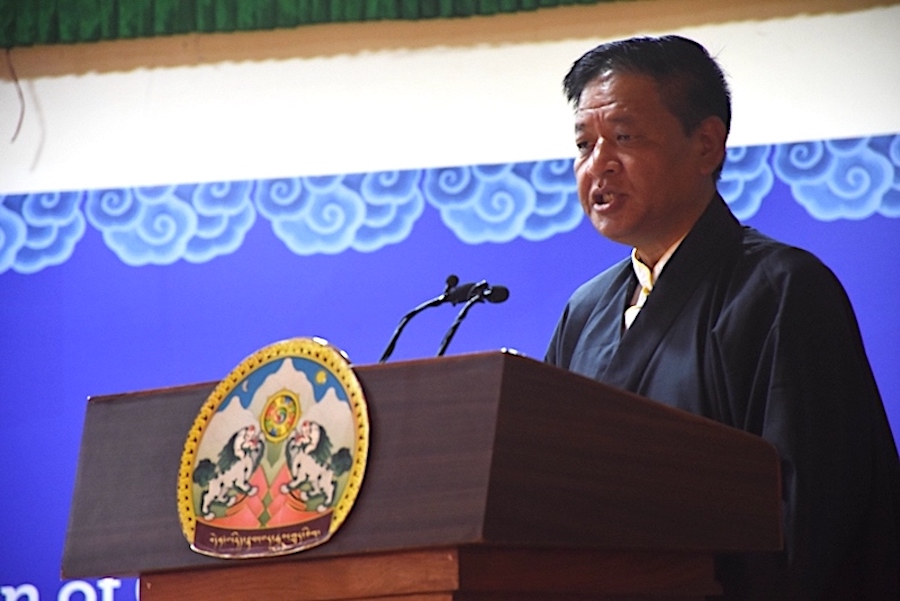By Tenzin Nyidon and Tenzin Dedan
Away from the loud touristy attractions of McLeod Ganj town, a tiny alley on the Jogiwara road lead to a building with a modest iron gate. On one of the floors of the building is a room that for the past four years, have provided safe shelter, refuge and a range of services to support Tibetan women and children who are victims and survivors of exploitation and sexual abuse. The Tibetan Women Helpline initiative is a collaborative effort between the Women Empowerment Desk (WED) under the Central Tibetan Administration and a well-known NGO Tibetan Women’s Association (TWA). This joint mission has been a long-standing effort in progress, spanning the capital of the Tibetan exile diaspora in Dharamshala and various Tibetan settlements throughout India.
At the heart of this initiative are three women; one of them, Tamding Dolma, the Outreach Officer is a staunch advocate for women’s rights and the longest-serving staff of outfit. “In a 2018 study report titled, ‘Status of Tibetan Women and Girls in India and Nepal’, conducted by Women’s Empowerment Desk (WED) and Social and Resource Development Fund (SARD) revealed instances of sexual and gender-based violence experienced by Tibetan women and girls within the community. It was then the idea of creating the Tibetan Women’s Helpline was conceived,” she said.
The organisation was born out of the need to address the issues of domestic violence, sexual and gender-based violence (SGBV) and discrimination faced by Tibetan women and children in exile. Since its very inception, the helpline has been providing essential services, including safe shelter, counselling, referral for legal and medical assistance, and sustenance fund for Tibetan women and children. The helpline services are broad, encompassing not only immediate crisis intervention but also long-term sustained support for as long as three months, which can be extended further after a thorough review of each case.
Tibetan women seeking assistance hail from diverse backgrounds, their needs ranging from addressing domestic violence to securing legal assistance. The helpline is more than just a shelter; it is a lifeline for women and children who have faced myriad challenges. It serves as a safe haven where Tibetan women can openly share their experiences and receive the vital assistance they require.
Beyond providing crisis intervention and counselling, this initiative places a strong emphasis on empowerment. It aspires to equip Tibetan women with practical skills and reading literacy, enabling them to secure suitable jobs, participate in workshops, and engage in training programs, including vocational training programs to improve their livelihoods for a better life.
Operation and framework
The Tibetan Women Helpline has been a collaborative effort between the exile Tibetan government’s WED and TWA, where the administration of the helpline falls under the purview of the TWA and its operations, programs, and capacity-building initiatives receive support from WED through the Tibetan Self-Reliance and Resilience Program (TSRR) under the CTA. Under the umbrella of the TSRR Program is the Sexual and Gender-Based Violence Response Program, which entails the establishment of committees and guidelines Prevention of Sexual Harassment (POSH) and the Prevention of Children from Sexual Offences (POSCO) within settlements and schools to address issues related to sexual and gender-based violence. The helpline then plays a pivotal role in this larger framework by providing referral services.
Tsering Kyi, the Program Officer at WED told Phayul that TWH operates on a principle of autonomy and mutual support. “WED does not directly involve itself in the handling of individual cases or small decisions made by the helpline operators. Instead, it trusts the operators with autonomy. At the same time, the helpline maintains an open line of communication with WED, reporting monthly cases. This observation and reporting mechanism serve to keep WED informed about the helpline’s activities and progress, without intervening in its day-to-day operations,” she said. She also added that when the helpline requires external networking, support from Indian NGOs, or assistance from the police, this is when TWA steps in. TWA leverages its established network with Indian NGOs and expertise in liaising with the local authorities to provide critical support to the helpline in navigating more complex cases and situations.
The Tibetan Women Helpline operates as a 24-hour emergency and non-emergency response service. With a telephone number (01892-220120) and Whatsapp number (6230937243), the helpline ensures that women, whether they find themselves in public or private spaces, have a way to reach out for help and support.
When a call is received, the helpline operators immediately take the necessary steps to address the situation whether it’s providing emotional support, facilitating communication with authorities, or connecting with the nearest police, welfare office, legal services, or other relevant resources. In many cases, the helpline operators go the extra mile by meeting with distressed women in person to provide assistance. The helpline prioritizes the security of data and confidentiality at every level of the process. By maintaining meticulous documentation and casework, the organisation ensures that the sensitive information shared by callers are kept safe and private.
While on duty, the helpline operators have encountered several success stories. Among those, one particularly poignant narrative stood out; a case where a Tibetan mother with two children who had reportedly endured domestic violence at the hands of her husband. The helpline became aware of this distressing case when the woman reached out for help. The mother not only faced domestic violence but also confronted the distressing situation of one of her children being allegedly held against her will by her in-laws. The helpline operators helped the woman in reuniting with her child and later relocated them to a different part of town.
Stigma and doubt
Within the tapestry of the tight-knit Tibetan community, the hesitancy to openly discuss and seek assistance for domestic violence and sexual assault has created a smokescreen of normalcy. Within this complex fabric of cultural norms and beliefs, the helpline struggles to reach its full potential due to multifaceted challenges deeply rooted in societal perceptions and stigma of seeking help.
According to the data maintained by Call Operator Sonam Dolma, over the past four years, the helpline has received a total of 91 calls. A breakdown of the calls received by year is as follows: 12 calls in 2020, 33 calls in 2021, and 19 calls in 2022. As of 2023, there have already been 27 calls. While the helpline has been a lifeline and a source of support for Tibetan women and children, it has also encountered its fair share of challenges over the years since its inception. The fluctuating number of calls received each year paints a rather unpredictable picture in terms of the overall state of security and well-being of women in the society.
The majority of these calls, accounting for approximately 39% to 40%, pertain to cases of domestic violence. Beyond domestic violence, the helpline has also dealt with a variety of other cases. These include issues related to sexual harassment, POSH, violation of the Protection of Children from Sexual Offences (POCSO) Act, mental health concerns, cybercrime, and inquiries regarding the legal services provided by the helpline.
Despite its services, the helpline faces a significant barrier: the reluctance of community members to seek help. The low number of calls received echoes a larger concern—limited awareness and hesitancy among Tibetans to seek help from the helpline. A recent online survey conducted by Phayul on 100 participants, delved into the community’s perception and willingness to seek assistance from the helpline. Astonishingly, while 55.7% were aware of the helpline’s existence, 44.3% remained oblivious to its presence. This disparity in awareness indicates the need for increased outreach efforts to bridge the information gap within the community. The survey also uncovered a nuanced picture regarding the community’s readiness to seek help. Despite a notable 46.2% expressing a willingness to reach out, a significant 47.2% remained uncertain, citing various reasons that hindered their decision.
Among the barriers highlighted by respondents was a preference to resolve conflicts privately, within the confines of their families. The perceived complexity of legal procedures further dissuaded many from seeking external assistance. Additionally, a poignant revelation emerged-some struggled to acknowledge the existence of violence within their community, fearing the repercussions of disclosure, including judgment and shame. This reluctance to engage with the helpline is compounded by a misconception among some community members who believe that such issues simply did not exist in their society.
Outreach and awareness
Despite commendable efforts by the helpline operators to disseminate information through various channels, including posters, social media platforms, and outreach programs during Women Empowerment Desk (WED) initiatives, the resonance of these initiatives within the community remains varied.
In the pursuit of heightened visibility, the helpline engages in multifaceted approaches. Informative brochures, guidance posters, and targeted social media campaigns create a ripple, contributing to increased awareness, particularly in urban areas like Dharamshala. However, bridging the awareness gap among older segments of the Tibetan community residing in settlements continue to be a challenging endeavor.
The helpline extends its reach beyond promotional activities, engaging with local institutions like the LHA Charitable Trust and the Tibetan Career Centre. Educational sessions conducted at these forums aim not only to inform but to initiate discussions on legal resources and emphasize the importance of emotional and mental well-being in the aftermath of violence.
Despite these concerted efforts, cultural norms and entrenched stigmas pose formidable barriers.
Choedon, the Counselor at the helpline and another instrumental figure in this initiative opined, “Within the close-knit Tibetan community, openly discussing domestic violence and sexual assault can be a formidable challenge. The stigma attached to these issues often leads to silence and creates barriers to seeking assistance, even when support services are readily available.”
Backlash and stereotypes
In the pursuit of supporting survivors of gender-based violence, the plight of the staff at the helpline echoes a larger struggle. Beyond the complexities of aiding survivors, they grapple with societal stereotypes and unjustified backlash, often bordering on their own mental well being.
The Tibetan Women’s Helpline, dedicated to shedding light on the hidden realities of violence against women, faces a paradoxical backlash in its efforts to raise awareness. Despite its earnest initiatives, including awareness posters strategically placed in the exile capital, critics from certain segments of the community perceive these endeavors as mere “publicity stunts”, undermining the genuine call for help they represent.
A disturbing consequence is the backlash directed at the helpline’s committed staff. These individuals, driven by an unwavering dedication to illuminate the grim realities of violence, have been unjustly stigmatized as disruptors of sanctity among family members or even labeled as “home-wreckers.” Threats and unwarranted criticisms imposed upon them have created an emotional burden, jeopardising their sense of safety and well-being, physically and mentally.
Moreover, misconceptions surrounding seeking help exacerbate the challenges. Some survivors harbor fear that engaging with the helpline’s services might attract attention and scrutiny from law enforcement. They fear that it will negatively impacting their lives, such as their paperwork to migrate overseas. These misconceptions present substantial barriers to effectively address gender-based violence within the community.
In the tireless pursuit of supporting survivors of gender-based violence, the helpline operators navigate a challenging landscape, often facing undue pressure and unjust accusations. Recognizing the significance of mental health amidst these trying circumstances, the operators undergo comprehensive training and counselling sessions. These sessions, conducted by reputable entities such as the Women Empowerment Desk (WED),Tibetan Centre for Conflict Resolution (TCCR), Tibetan Legal Association (TLA), and other notable institutions including Cousera/UN Women Training Centre, Child Safety at Work, Shakti Shalini, Migration and Asylum Project, Martha Farrell Foundation, Jagori Rural Charitable Trust, and The Alternative Space (TAS)-Khadijah, aim to nurture the mental resilience and well-being of the helpline operators.
These sessions are not just about equipping them with skills and knowledge to better assist survivors, but also about fortifying their own mental health. The training encompasses a spectrum of topics, including conflict resolution, legal guidance, psychological support, and specialized training in gender-based violence issues.
In the quest for heightened awareness and community engagement, the journey continues—a journey that seeks to illuminate paths, break down barriers, and foster a culture where seeking help is not a sign of weakness but an act of courage and empowerment.











One Response
Such elaborate writing! Appreciate the great effort you took to write. But, I see every body is concentrated in and around gangkyi.
I live in one of the settlements. Great steps taken by the great NGOs and Women’s Desk are unheard of in here.
Let me get straight to the point. I am a man. I see men are just disowning women for no reasons. And, they live their lives as usual while the women and the kids suffer (no means to provide to the kids, no home).
Ours is small community. Very easy to collect relevant data. I wonder how these cases go unnoticed.